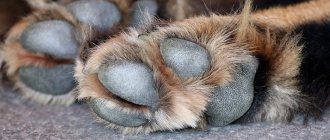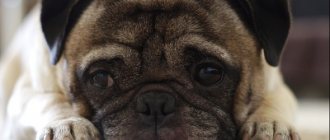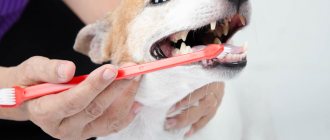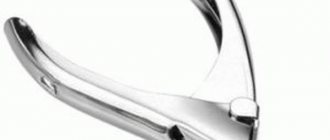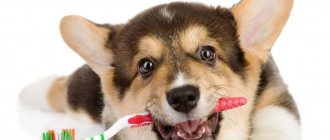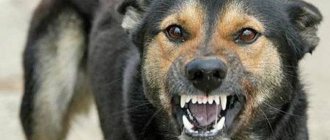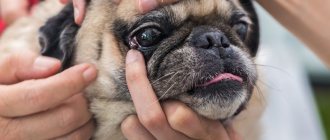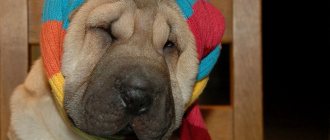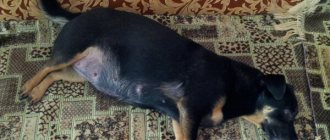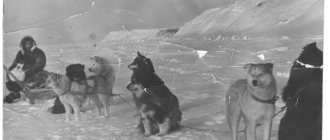To answer the frequently asked question: “Can dogs cut their own nails?”, it is necessary to consider it in detail. Nail trimming is a common cosmetic procedure in dog grooming salons. It is important both for the appearance of the pet and for its health. Overgrown claws can cause great discomfort and harm to the dog, for example, provoke various infectious diseases. Long claws also contribute to the curvature of the dog’s gait. Therefore, your pet's nails should be trimmed regularly. This can be done by a groomer or the owner himself at home, but only after first studying the structure of the claw and the safe method of cutting.
Anatomy of a dog's claws
Before trimming, it is important to study the structure of the claws and features.
Each dog has its own form of horn formation:
- cat and dog - curved;
- hare - long, straight, sharp.
The claw itself consists of three parts:
- Roller and gutter. This part is covered with a thin wax-like skin. From below, the cushion practically merges with the fingertip; from above, it can be felt very well. The groove is a groove on the sides along the entire length of the claw, formed by the folds of the skin. The pulp corresponds to its size.
- Wall and rim. This is the visible part of the claw.
- The underside is partially covered with skin.
Expert opinion
Anna Abramenko
An avid dog lover. Experience in veterinary medicine since 2009.
Ask a Question
It is important to consider that, unlike human nails, a dog’s claw is “living” and sensitive. This is a protective shell for the nerve bundles and blood vessels that make up the pulp.
Can my pet's nails be trimmed?
Some owners, when getting a dog, are not even interested in how to properly care for it, and then various problems arise with the pet’s health. For example, many people do not know whether it is possible to trim a dog’s mustache, or whether it is possible to trim the nails of a domestic dog. This all relates to important points that the owner must know and follow. After all, how the pet will feel and look depends only on the owner. This is especially true for decorative small breeds that do not know how to take care of themselves and cannot do without human help. Therefore, we will consider in detail whether it is possible to trim the claws of a domestic dog, why this is necessary, what will happen if you leave overgrown claws, and how to trim claws at home.
Why does a dog need nail trimming?
One of the reasons why it is necessary to give a dog a pedicure is that the dog, unlike a cat, does not have the ability to grind on its own, for example, on furniture, carpet or other special surface. The pet is deprived of natural grinding, since it does not lead an active lifestyle, like street stray dogs. Animals that are constantly outdoors have their claws worn down on the asphalt, so they do not cause much harm. It is unlikely that there will be an owner who will run all day long with his four-legged friend on a hard surface. Even if you walk your dog often and for a long time, this will not help, since most likely these walks will be in parks where there is soft ground with grass.
But still, why is it so necessary to trim your dog’s nails? The problem is that long claws interfere with movement and negatively affect the dog’s gait. He cannot place his paw correctly, begins to experience pain when walking, and lameness appears. After some time, the joints of the paws acquire curvature, which will provoke diseases of the musculoskeletal system. And if the musculoskeletal system stops functioning correctly, therefore, paralysis of the limbs occurs. This is just one consequence of uncut nails; various other diseases, in most cases infectious, may also appear. Therefore, in order to avoid such terrible problems, you just need to regularly trim your dogs’ nails.
Tip: Can a dog's nails be trimmed regularly? It’s not possible, but it’s necessary! But here's the problem, they don't like to do it. Therefore, it is necessary to teach pedicures from an early age so that the dog feels calm.
How often should a dog's nails be trimmed?
The duration of the procedure depends on the size of the breed. Control the length of your pet’s nails; to do this, you should carefully examine your dog’s paws. In small breeds they grow very quickly, but are deprived of natural wear, since they do not lead an active lifestyle, have little weight, and are often carried in the arms. Therefore, they need to have their nails trimmed once every two weeks. Representatives of large breeds have claws that grow more slowly, so they do not need pedicures often. It is advisable to carry it out once a month, and sometimes every two months is sufficient. But still don’t forget to inspect the paws. When moving, the dog makes a clicking sound and often bites its nails, which means it’s time to take up the instrument.
Tip: Please note that for fluffy dogs it is necessary to remove the hair in the toe area, since the long hair makes the claws invisible. Hair removal must be done immediately before the pedicure.
Consequences of neglecting nail trimming
In order for your four-legged friend to be healthy and able to run on the green grass, you need to monitor and care for him. Healthy, strong paws can only be with trimmed claws, otherwise the gait will be crooked and it will be impossible to stand the limbs straight. Let's look at the consequences of ignoring the process:
- Of course, the most important and important problem is the deformation of the limbs, which will lead to diseases of the spine.
- The dog will limp all the time and at the same time feel pain.
- The keratinized nail tissue will dig into the soft skin, injuring it. Therefore, there is a high probability of infection and then inflammation of the paws.
- On the dewclaws, which are higher than the rest, strongly overgrown claws can catch on some object, causing great injury.
- Long claws are dangerous because when scratching, for example, an ear or eye, a dog can harm itself. If injured, dirty paws will cause infection and further inflammation.
- If there are small children in the house, then the pet can scratch their delicate skin, again the possibility of infection.
- Over time, the nail will grow into the pad of the finger. Then you will have to go to the veterinarian, only he will be able to perform an operation to remove it.
- Damage to property and upholstered furniture has also not been canceled. Your friend will suffer from pain if the tip of the claw gets caught on the sofa and breaks off.
What happens if you don't trim your dog's nails?
Failure to properly care for a dog’s nail plate leads to problems with its health.
The most common of them:
- deformation of joints and bones of the limbs;
- ingrown claws, leading to injury and the spread of inflammatory processes;
- lameness, problems with the spinal column, skeletal curvature;
- pain when walking;
- the appearance of wounds on soft tissues, their possible infection, suppuration of the paw;
- blood poisoning.
Additionally, long claws bring discomfort to the owner: in the house, a dog, trying to sharpen them, damages furniture, things, floors, and causes material damage.
Dewclaws
Beginning dog breeders have no idea whether dogs' nails are cut on their dewclaws. A haircut is necessary. The dewclaws are located at a great distance relative to the ground; the ability of the claws to grind down naturally is not observed. If you start the growth of claws, the likelihood of your pet getting injured will increase - as a result of the long claw on the dewclaw catching on some object. A pet can completely lose the claws on its dewclaws, causing unpleasant blood loss, pain and possible blood poisoning.
Stages of the procedure
To properly trim your dog's nails at home, you should follow the instructions.
First you need to treat the instrument using sterilization, alcohol, antiseptic or boiling water. Even if it is new, from the factory packaging. Wash your hands with soap, treat with an antiseptic, and wipe. The correctness and safety of the procedure depends on cleanliness. If there is infection, inflammation, or wounds on your hands, it is better to postpone the haircut or entrust it to a professional.
Wash with clean water and dry the dog's paws. Carefully examine the claw plate and determine the location of the cut. It's easier to do this if the dog's nails are beige or brown. Black ones will be more difficult to cut. To identify the pulp, you can use a bright flashlight or contact your veterinarian. For better access to the claws, you can press on the dog's toe pad.
The tip that needs to be removed is usually lighter and is 2-3 mm. It is better to do this consistently, so as not to cause pain and discomfort to the pet, or accidentally touch the pulp.
It is darker in color, filled with blood vessels and nerve bundles. A careless approach to this procedure may result in injury, pain and stress to the dog, and damage to nerve endings.
If the fur on the paws interferes with inspection, it is trimmed with safety scissors with rounded ends. Additionally, this measure will remove the area of accumulation of dirt and possible infection. If there are minor damages, calluses and cracks, they need to be treated.
Expert opinion
Anna Abramenko
An avid dog lover. Experience in veterinary medicine since 2009.
Ask a Question
If there are kinks, fungus, or significant damage to integrity, you should contact a veterinarian. Injured plates are not cut so as not to aggravate the animal’s condition. Using a special file, the claws are filed.
To start the procedure, you should give the dog the “Paw” command and take it in your hand, securely fix it, praise him for the correct execution, and reward him with a treat. Breeds of decorative dogs and small animals can be picked up.
Place large pets on the floor, and you will need an assistant and a leash. The partner should firmly grasp the animal by the neck and support the paw. During the procedure, it is important to remain calm, confident, and speak kindly and affectionately to the dog. To create a good mood, you can stroke it.
Expert opinion
Anna Abramenko
An avid dog lover. Experience in veterinary medicine since 2009.
Ask a Question
If the dog is nervous, bites and breaks out, it is recommended to postpone the procedure until later. The fear that arises can lead to sad consequences - the dog will stop trusting the owner, and the process of trimming its claws will become real torture for it.
The front paws should be treated first. When the procedure is completed, you can move on to the hind limbs after a 3-hour break, if the dog is friendly. This manifests itself in the absence of aggression and stress. First, it is advisable to treat the fifth claw, located above the others.
At the initial stages of accustoming to the procedure, the claws on the hind legs are trimmed while the dog is lying on its side. With experience, this can be done standing. So that she is not afraid, you should let her sniff the tools - specialized nippers, scissors, files.
Then make a cut with a nail clipper, placing it at an angle of 45 degrees. The size of the plate to be cut should be 0.3 cm smaller. Then sand the cut area with a nail file until smooth and to the desired length. This procedure will prevent delamination and achieve the correct shape of the claw.
Black horny formations need to be trimmed more slowly, 0.5 mm per step. If a lighter or pinker cut appears, you should stop to prevent the dog from damaging the pulp. If a plate is injured, you can use the tips from the “Treatment and Prevention of Wounds” section.
When the trimming process is completed, you need to praise your pet and give him a well-deserved treat.
If nail trimming is being done for the first time, you should not try to trim all the nail plates at once. This must be done systematically - 1-2 pieces at a time. Over time, the pet will get used to it, and the procedure will become faster and easier.
Frequency for adults – every 4 weeks, for puppies – 1.5 months.
The importance of haircut
The importance of cutting dog nails is difficult to overestimate.
If the nails are not trimmed in time, the growths easily penetrate the skin, causing wounds and infection. Paws with wounds end up in a dirty puddle, in a trash heap, on the ground. An ingrown toenail can cause serious discomfort to your dog, causing constant pain. If the claw has not yet grown into the skin, the paw is not able to function normally, clench and unclench as it should. Improperly growing nails lead to lameness and skeletal disorders in dogs.
Uncut nails, even without growing into the paw, begin to greatly disturb the pet and the owner. Delay is costly for the owner - it is impossible to trim an ingrown toenail on your own due to the pet’s resistance; few people have veterinary knowledge that can help heal a wound on the paw without consequences. Calculating the time to trim your dog's nails is easy. As soon as the claws click and click on the floor, it’s time to trim. By the way, an additional reason for the need to trim claws is indicated. Because of the distinct knocking, the house can easily recognize that the dog has decided to eat or drink some water in the middle of the night.
Required Tools
Before trimming and grinding claws, it is important to prepare the tools - sterilize them, treat them with alcohol, an antiseptic solution, or pour boiling water over them.
You will need the following set:
- nail clippers of various modifications;
- files with hard coating;
- hemostatic agents;
- antiseptics.
Ordinary scissors cannot be used, only as an auxiliary material for removing hair that interferes with the inspection of the paws.
For small breeds, miniature individuals, for example, Jack Russell puppies, a nail clipper with a limiter or a guillotine with holes for the nail plates is suitable.
It is better to cut a large dog using special clippers with sharp blades made of steel or brass. They should be treated with chrome on top. Without a protective coating, the tool quickly rusts and deteriorates.
To stop bleeding, use talc or baby powder, or, if they are unavailable, use flour. When treating wounds, use cotton pads or sterile swabs with iodine, peroxide, and potassium permanganate.
It is important to prepare a treat to praise your pet: if he followed the command correctly, wait patiently for the pruning to reward him.
Structural features and types of claws of different breeds
Before trimming nails, familiarize yourself with the structure of your pet's paw, although different breeds have different paw shapes, the structure of the claw is the same for all. The claw is triangular in shape, wide at the base and sharp at the end. Inside it there is a pulp with many nerves and vessels, which makes it very sensitive to injury. It is clearly visible on light-colored nails; unfortunately, it is not visible on black ones, which makes it difficult for inexperienced breeders to trim.
Equally important is the choice of the right tool for cutting nails; you can choose it in specialized stores. You should not use regular nail scissors; they peel off the nail, so they are not suitable for this procedure. We select the size of the tool based on the breed of the dog.
There are three types of nail clippers:
- Nail cutter - scissors or pruning shears (one blade is straight, the other is curved): the structure and principle of operation are similar to scissors, the dog’s claw is located between two blades, and they are connected after pressing the handles. The downside is that after using scissors, the sharp end of the claw must be smoothed with a nail file.
- Nail cutter - guillotine: has a hole into which the claw is placed, the handles are compressed, the blade is lowered and cuts off part of the nail plate. Disadvantage: using a guillotine nail clipper is inconvenient for cutting off too thick nails of large breeds. After using the guillotine, the sharp end of the claw will have to be smoothed with a nail file.
- An electric scratching post (handle and attachment rod with a grinding stone) grinds down the claw quickly and painlessly. The grinding stone grinds down the overgrown thin tissue of the claw, the cap protects against excessive grinding and prevents bleeding. The claws are smooth, the ends are rounded. Disadvantage: the tool makes noise, which can frighten the dog; when rubbed, the surface of the nozzle heats up.
Treatment and prevention of wounds
In order for the procedure to take place without pain and injury, it is necessary to prepare the dog mentally, give it sedatives based on herbs to dull nervous excitability. A hyperactive dog can be medicated and placed on a leash.
If the pulp is injured, bleeding may occur.
To stop it, you will need special wipes, talcum powder, baby powder or regular flour. Damaged skin should not be treated with fucorcin, alcohol solutions, iodine or brilliant green, as this will bring additional pain and stress to the pet.
If a dog jerks its paw while trimming its claws and the plate explodes, it is necessary to calm it down and distract it. In the area of the metatarsus, grab it with gauze or a bandage and secure it well.
To relieve swelling, pain, and stop bleeding, apply ice, frozen meat or other cold, wrapped in cotton or cellophane. For open ruptures, you can use pharmaceutical preparations - a solution of lidocaine or novocaine as a lotion, and then visit a veterinarian.
In case of any injury, cutting the claws further is not recommended. You should also not allow your dog near water to avoid infection.
Possible errors and complications
If an animal is injured, it is necessary to calm it down; after disinfection, lightly sprinkle the wound with powder or starch, but do not rub it in under any circumstances - this will worsen the situation.
It is important that the animal remains at rest for 20 minutes and does not run, provoking new bleeding.
Improper or careless care of your pet's claws leads to a number of consequences, often extremely unpleasant.
When caring for an animal, you should always remember that untimely or careless trimming of animal claws is fraught with consequences such as:
- disorders in the development of joints;
- negative and irreversible changes in paw position;
- deformation in gait and, as a result, in the pet’s spine;
- constant pain;
- long-term illnesses.
Sometimes, in order to save the life of a pet, it is necessary to undergo declawing operations. Such indications include the following:
- ingrown claws – complicated cases;
- improper development of the claw, fused claws;
- the occurrence of gangrene and other serious consequences;
- serious injuries and inflammation, frostbite and burns;
- oncological processes.
They also remove the so-called wolf claw (“dewclaw”) - rudimentary claws . Operations comply with breed standards. In developed countries, the operation is condemned by human rights activists.
To learn how to trim a dog's nails at home, watch the following video.
Where is it better to carry out the procedure: at home or in a veterinary clinic?
The choice of place for the procedure depends on the nature of the animal, the skills and mood of the owner.
If you don’t have enough experience yet, you can call a veterinarian at home. This will allow your dog's nails to be trimmed professionally, without unnecessary stress for the dog.
Expert opinion
Anna Abramenko
An avid dog lover. Experience in veterinary medicine since 2009.
Ask a Question
Your pet may not like a visit to the veterinary clinic - he will be afraid, nervous, and pay attention to other animals.
Types of nail clippers. Which one to choose: guillotine or sickle blades?
There are a number of gadgets available at pet stores for trimming your dog's nails, but they generally fall into two groups.
Guillotine Nail Cutter: As the name suggests, these have a single blade that cuts the end of a dog's nail. They are more suitable for small and medium dogs as they are not very powerful. In addition, their use requires the obligatory alternate placement of each claw in a special hole, after which the claw can be cut off.
Nail clippers with sickle-shaped blades: used, as a rule, for strong nails of large and giant breeds of dogs. These nail clippers have curved blades and a special limiter that adjusts the width of the blade, allowing you to adjust it to the size of your dog’s nails.
Possible problems
The ideal time for the procedure is after feeding or a long walk, then the dog is obedient, trusts without boundaries and is calm. However, trimming the nails itself can cause discomfort in the dog.
At the same time, she breaks free and tries to bite or run away. To prevent this from happening, you need to hold her well, talk gently and distract her with her favorite toys and treats.
From a young age, a puppy can be accustomed to this manipulation, doing everything gradually. At first, just familiarize him with the tools, next time additionally examine the claws, and another day try to cut them. If the dress rehearsals were successful, you can pick up the nail clippers and familiarize the animal with them.
When grooming a dog, it is important to trim and file its nails. The correctness of the procedure will allow you to avoid negative consequences and injuries, and will preserve your pet’s physical and mental health.
Tips and warnings
Nail trimming is a very important procedure. If you do not take care of the nails, they will grow endlessly and cause inconvenience to both the dog and the owners.
Untimely nail trimming can cause your dog to:
- Violation of joint development;
- Cause irreversible changes in the position of the paw;
- Change in gait;
- Cause constant pain.
Determining when to trim a dog’s nails is not difficult: as soon as the claws “clack” around the house, you need to take up the nail clipper.
If your dog is very nervous about the nail trimming procedure, panics and does not even allow you to pick up its paw, you should contact a veterinarian - at the veterinary clinic, the dog will be given a sedative and the nails will be trimmed quickly and accurately.
I recommend: How to protect a dog in winter: dress it in clothes, protect its paws from reagents, adjust its diet
Praise and reward for patience
In addition to preparing the tools and the dog itself for the procedure, be sure to prepare a treat. This way the manipulation will be associated only with good impressions.
Each manipulation of an individual finger should be rewarded with praise and treats.
How to trim a puppy's nails?
While the puppy is still small, it is quite possible to carry out manipulations with the claws at home, without resorting to the help of professionals. You should try to consolidate in a young dog the most pleasant emotions associated with trimming claws:
- Before the procedure, the baby needs to be given a good walk to reduce his physical activity.
- After washing his paws, you should put him on your lap and play with him a little to calm him down.
- The puppy needs to familiarize himself with the tool - the nail clipper - in advance, so as not to be afraid of its smell and the sounds it makes. It is recommended to keep all the tools for caring for the animal within sight and then, once he gets used to it, he will not react violently when he sees them.
- Before grooming, you need to stock up on treats for the puppy so that the procedure turns into an expected reward for him, and not torture.
- As a rule, the puppy’s claws are still soft and transparent, so there are no problems with detecting the pulp.
- Place the edge of the claw in the hole of the claw cutter and bite it off.
- Then we process the uneven edge of the claw with a file.
Step-by-step instructions for trimming nails
Trimming your dog's nails is easy if you follow the instructions. First, prepare all the necessary tools and disinfect the blades. Just in case, prepare cotton pads, hydrogen peroxide, and means to stop bleeding. A nervous or fearful dog will need another treat. The pet's paws must be clean, without wounds or scratches. It is recommended to trim the fur between the toes in advance so that it does not interfere.
To do everything right, it is better to follow the step-by-step guide.
- Pet the pet, sit it down or lay it down so that it is comfortable.
- Take the paw in your hand and stroke it. Grab one dog's finger with your thumb and forefinger and apply a little pressure to the base of the claw, but do not squeeze too hard.
- Determine how long to cut, position the nail clipper at an angle of 45˚ from top to bottom.
- In one movement, cut the claw perpendicular to the direction of growth.
- Finish the cut with a file – remove nicks and round the edges.
In this way, cut off all the claws. It is recommended to start with the front paws. The rear ones are easier to work with when the pet is lying down. After the procedure, be sure to pet the dog, praise it and give it a treat.

